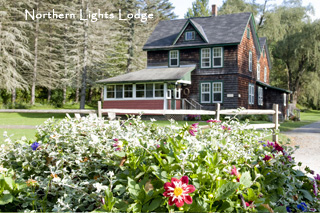Fall Workshop, October 2 – 6, 2017
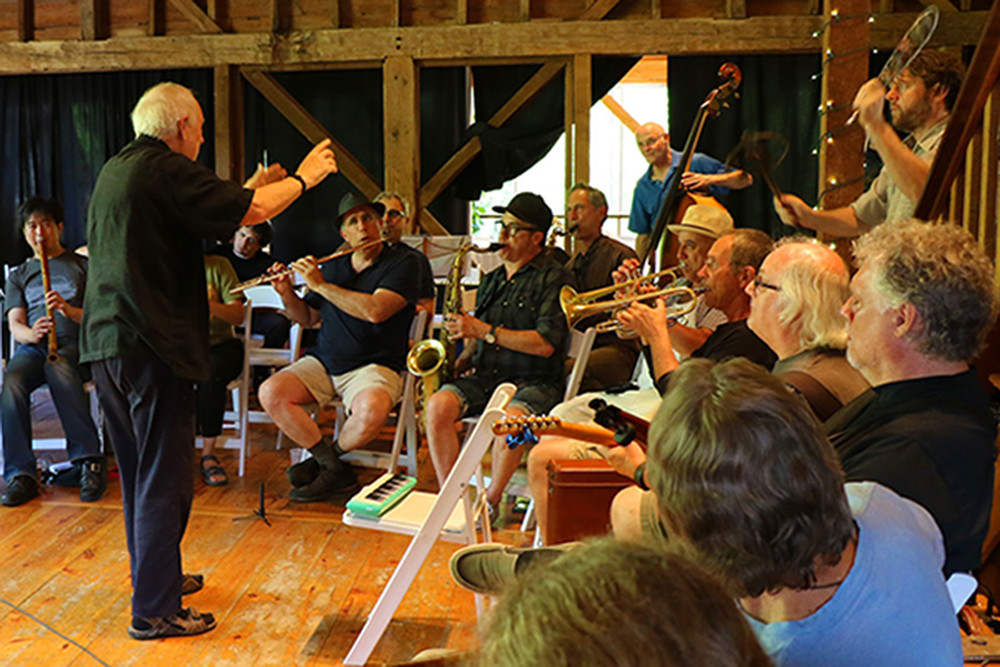
CMS Spring 2017 Workshop. Photo by Karin Wolfe
Guitarist, composer and bandleader Mary Halvorson, Creative Music Studio (CMS) associate artistic director and percussionist Billy Martin, and Turkish multi-instrumentalist Omar Tekbilek join CMS co-founders Karl Berger and Ingrid Sertso as Guiding Artists for the CMS Fall 2017 Workshop intensive, October 2 – 6, at the ear-inspiring Full Moon Resort in Big Indian, NY.
CMS’ Fall Workshop, in the height of the blazing autumn colors, features one Guiding Artist(s) working with participants in two workshops each day, creating multiple opportunities for artists to work directly with participants as individuals or in ensembles. As in the past, there will be daily CMS basic practice (body movement, breath work, rhythm and vocal training), as well as 90 minutes each day with Karl Berger leading orchestra of improvisers. Bassist Ken Filiano, saxophonist Maria Grand, and additional Guiding Artists will be on hand to work with participants on a more personal level, informally coaching, playing and tutoring daily.
Recent testimonials from workshop participants: “My playing was reborn; I’ve been given the key to a musical language shared by few; CMS is beyond musical, it’s therapeutic; The best musical experience I have had; It’s a dream workshop; CMS is an unsurpassed life-changing experience; CMS workshops are like a reset switch for your creativity and spirituality; I found my freedom at CMS, in my ability to play what I hear and to hear what I play; CMS is more than a lesson in music, it is a lesson for life.”
CMS Workshop Guiding Artists in 2013 – 2017 have included Vijay Iyer, Steve Coleman, Dave Douglas, John Medeski, Henry Threadgill, Pauline Oliveros, Fabaian Almazan, Nels Cline, Susie Ibarra, Joe Lovano, Marty Ehrlich, John Hollenbeck, Rudresh Mahanthappa, Hassan Hakmoun, Adam Rudolph, Billy Martin, Oliver Lake, Don Byron, Tyshawn Sorey, Peter Apfelbaum, Tony Malaby, Cyro Baptista, Marilyn Crispell, Min Xiao Fen, Joe McPhee, Taylor Ho Bynum, Angelica Sanchez, Steven Bernstein, Jason Hwang, Kirk Knuffke, Kenny Wessel, Steve Gorn, Mark Helias, Tom Rainey, Maria Grand, Tanya Kalmanovitch, Thomas Buckner, Judi Silvano, Iva Bittova, Harvey Sorgen, Tani Tabbal, Ken Filiano, Badal Roy, Warren Smith, Omar Tamez, and John Menegon, in addition to Creative Music Foundation co-founders Karl Berger and Ingrid Sertso.
https://www.youtube.com/embed/koRU8O9LLCE
A typical day at the CMS Workshop is:
8:00 – 9:30 Breakfast
9:45 – 10:05 Body Awareness
10:15 – 11:15 Basic Practice (rhythm/vocal)
11:30 – 1:00 Master Class/Workshop
1:00 – 2:00 Lunch
2:10 – 2:25 Body Awareness
2:30 – 5:00 Master Class/Workshop
5:10 – 6:30 Improvisers Orchestra
6:30 Listening Meditation
7:00 – 8:15 Dinner
8:30 – ?
Performances/JamsLate night consists of playing music in the Roadhouse and the Barn, unscheduled sessions, conversations, bonfires, or simply stargazing from Full Moon’s gorgeous location in the heart of the Catskill Mountains, with the historic Esopus Creek running through the expansive property.CMS’s nonprofit parent, the Creative Music Foundation, is fundraising in order to offer scholarships for the workshop. For more information and online registration, please call the Full Moon Resort, 845-254-8009, email: [email protected] Monday-Friday, 9am-5pm (EST), or click this link to register.
Daily Schedule (subject to improvisation)
Monday, October 2
4:30 – 6:30 Orientation/cocktails
Opening orientation in the main building, hosted by Karl Berger, Ingrid Sertso and other Guiding Artists
Introducing featured artists and any special guests
Brief review of daily workshops, activities, performances
Meet and Greet with Open Bar and Hors D’Oeuvres
6:30 – 8:00 Dinner
8:15 – 10 Performance
10 – ? Jams
Tuesday, Wednesday, Thursday, October 3 – 5
8:00 – 9:30 Breakfast
9:45 – 10:05 Body Awareness
10:15 – 11:15 Basic Practice (rhythm/vocal)
11:30 – 1:00 Master Class/Workshop
1:00 – 2:00 Lunch
2:10 – 2:25 Body Awareness
2:30 – 5:00 Master Class/Workshop
5:10 – 6:30 Improvisers Orchestra
6:30 Listening Meditation
7:00 – 8:15 Dinner
8:30 – ? Performances/Jams
Friday, October 6
Breakfast
Farewell and Departure
WORKSHOP DETAILS
one of the most engaging musical experiences I have ever taken part in.”
I really don’t know how it could have been better.
https://www.youtube.com/embed/k5fDSyrvJ-E
https://www.youtube.com/embed/f6m-pp-rCxE
Guiding Artist Biographies
Mary Halvorson, guitarist, composer, bandleader
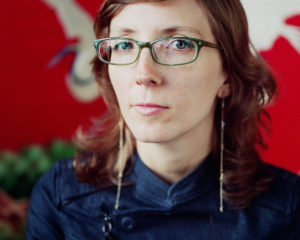
Guitarist/composer Mary Halvorson has been called “NYC’s least-predictable improviser” (Howard Mandel, City Arts), “the most forward-thinking guitarist working right now” (Lars Gotrich, NPR.org) and “one of today’s most formidable bandleaders” (Francis Davis, Village Voice). Ms. Halvorson is best known for her longstanding trio, featuring bassist John Hébert and drummer Ches Smith, and more recently for her solo guitar project, Meltframe. She has several other projects as a bandleader including a quintet, septet and octet. Collaborative projects include a chamber-jazz duo with violist Jessica Pavone, the avant-rock band People and the collective ensembles Thumbscrew (with Michael Formanek and Tomas Fujiwara) and Secret Keeper (with Stephan Crump). Ms. Halvorson is also an active member of bands led by Anthony Braxton, Taylor Ho Bynum, Trevor Dunn, Tomas Fujiwara, Ingrid Laubrock, Joe Morris, Tom Rainey, Mike Reed and Marc Ribot, among others.
Billy Martin, percussionist, educator, visual artist
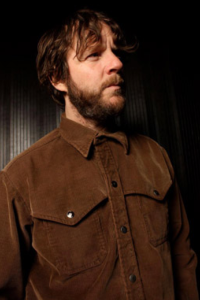
Above all else, Billy Martin believes in the power of unguarded expression to capture glimpses of the truth – sometimes only fleetingly, sometimes for extended, intoxicating stretches. He pursues the ecstatic and the insightful from a variety of vantage points: as a drummer and percussionist, as a composer, as a filmmaker, sculptor, visual artist, and even as a carpenter. To varying degrees, each endeavor is marked by Martin’s dearly held belief that unfettered improvisation and an honest commitment to the moment at hand can bring about new levels of understanding, new perspectives, new sonic textures, and a more profound emotional impact. “In any circumstance, any medium,” he reflects, “you need to be sincere with yourself and with your audience. This is who you are, and you’ve got to be trying as hard as you can to create something for the situation that’s new and fresh. There are going to be some mistakes, it may not be perfect, but you’ve got to be willing to take that chance at any given moment.”
While Billy Martin’s own creative journey has had innumerable forks and bends, he is best known to music enthusiasts as one-third of the indescribable Medeski Martin & Wood. About to enter their twentieth year as a performing and recording aggregation, Medeski Martin & Wood are an entirely unique instrumental ensemble, able to apply principles from a staggering range of traditions (from free and modern jazz to classic R&B and well beyond) while remaining eminently accessible. Via fifteen albums, tireless touring (performing everywhere from jazz clubs to jamband festivals), and collaborations with the likes of John Scofield and John Zorn, the trio has united audiences from disparate corners of the musical universe who react with equal awe and enthusiasm to the band’s infectious grooves and undiminished exploratory zeal.
Few if any major acts are able to simultaneously function so successfully – both artistically and commercially – as a laboratory as Medeski Martin & Wood have, and their work exemplifies many of Martin’s ideals and principles as an improvising composer/performer. Forever refining and rediscovering his own signature sound, Martin vividly explores these notions of creative identity, of surrendering to the moment, of developing one’s own artistic voice, in Life on Drums, his feature-length directorial debut, which will be released on DVD by Vongole Films on October 8th, 2010. Sumptuously filmed in a disused New Jersey radio station, both informative and atmospheric, Life on Drums combines conversations with solo and group performances (some improvised, some composed) to create an engrossing portrait of Martin’s evolving musical aesthetic.
“Life on Drums is my reaction to all the bad instructional videos I’ve seen,” Martin elaborates. “Much of what’s out there tends to put a lot of focus on technique, but most creative things don’t come from technique. I want the viewer to see this and come away with the idea that they can be an artist – you don’t need this full spectrum of technique before you can start thinking creatively.” Accompanying Martin on this voyage is Allen Herman, Martin’s first drum teacher. The two converse about matters both practical and artistic, and it is their easy yet insightful rapport that helps to illuminate even the most elusive ideas. “It’s this strange kind of karma, this nurturing feeling I get from him,” Martin continues. “We first met in 1974, when he was my teacher. He has been in and out of my life a few times since then. He even stopped playing drums for a while. But now he’s turned it around, saying I am the one who is nurturing him. He is ecstatic to be back in the drumming world…
When Martin first began studying with Herman, he was an energized, precocious teenager, residing in New Jersey – having relocated from Manhattan at age ten. His father, a classical violinist, photographer, and audiophile, ensured that Martin was surrounded by music for as long has he can remember. When recorded music wasn’t blasting from the ample sound system in the basement, the Martin home was alive with rehearsals and young Billy’s growing percussive prowess – initially sparked by the discovery of his older brother’s abandoned trap set. By high school, Martin’s musical obsessions began to flower: he was writing percussion cadences for the school marching band, performing with the student jazz ensemble, and had his first garage band – a power trio whose repertoire ranged from George Benson to Van Halen. He even subbed for Herman in the pit band of the Broadway show Bob Fosse’s Dancin’.
Upon graduation from high school, Martin bypassed full-time college, electing to make a go at being a professional musician in New York City. His arrival there in 1981 coincided with the emergence of a downtown music scene that dovetailed perfectly with Martin’s own sensibilities, holding equal reverence (or irreverence) for free improvisation, classic jazz, film music, and even the kitschiest of pop culture. Embracing every possible opportunity, Martin performed alongside such luminaries as John Scofield, Bob Moses, Bill Frissel, Cyro Baptista, Dave Liebman, Jerome Harris, and more. He went on his first tour as a member of Moses’s ensemble, and indulged his fascination with Brazilian rhythms by co-founding the group Batucada, who were a fixture on New York’s Brazilian scene for two years. After touring and recording with Chuck Mangione for two years (1987-1989), Martin reinvested himself in the downtown scene, participating in John Zorn’s Cobra improvisational game pieces and performing with John Lurie’s Lounge Lizards.
Medeski Martin & Wood first convened in 1991, embarking on their remarkable journey, which continues to this day. By then, Martin was a formidable musician, armed with a rich cultural understanding of rhythm and a vast, tastefully deployed technical vocabulary. Over the past ten years, he has begun to impart unique musical philosophy in instructional contexts ranging from master classes to private instruction to his book, Riddim: Claves of African Origin, released in 2006. “I think that teaching can be as creative as performing and composing,” he explains. “I believe strongly that creativity and individual style is important. I feel so strongly about that, and the only way to be active or push people in that direction is to offer my teaching. Hopefully that will have a little ripple effect on the next generation of musicians.”
When not performing with Medeski Martin & Wood, Martin continues to collaborate with other musicians in improvisational projects, many of which are documented on his own Amulet Records imprint, which he founded in 1995. He also records and performs solo – with results ranging from the exploratory to the downright funky, as heard on his triple-LP/CD breakbeat extravaganza illy B Eats – and has taken an increased interest in composing for both percussion and chamber ensembles. An album of Martin’s chamber works, Starlings, was released by John Zorn’s Tzadik label in 2006. “My way of composing is to write sketches out to musicians,” he explains, “and to then let them work in a way that allows them to improvise based on the limitations I have given. Even when I work with my students and my percussion ensembles, there is always a little room for them to interpret my compositions. It’s exciting to me because you never know exactly what’s going to happen – it’s more rewarding for me and for the listener.”
Parallel to his musical adventures, Martin is an accomplished visual artist, whose drawings have been featured on album covers and in gallery exhibitions. His burgeoning interest in filmmaking has resulted in several music videos and short subjects, with Life on Drums being his first feature-length project. “Making videos and films – the whole idea of images moving along in a time frame: that’s very musical and rhythmic,” he reflects. “Whether it’s music or films or my drawings, I take the same approach: I improvise. I do have conceptual ideas I try to realize, but I think the best stuff comes out of improvisation. It comes from the same place, the same creative part of myself in the moment.”
With so many outlets existing for his creative energies, Martin is always in the midst of multiple projects. Even now, as he is helping to formulate Medeski Martin & Wood’s upcoming 20th anniversary celebrations, he is working to bring to light recently-recorded chamber compositions for a bass clarinet quartet, a documentary of the making of Medeski Martin & Wood’s Shackman album from recently-recovered videotape footage, and a sculpture project that combines composition with visual arts via graphically notated scores welded to oversized metal canvases. “It’s all more complicated than ever,” Martin concludes, “because now I have two boys, who are going to turn seven and ten soon. Handling the family life and home life with my work and creative projects is a delicate balance – but I have a studio-slash-shed in my backyard that I can use to get away and still be home. Honestly, I try not to keep everything too separate: it’s all creative living, it’s all satisfying. It feels good with each little thing I accomplish. I just have to give myself the time to improvise, to experiment. Usually I find the meaning later, after I’ve created it.”
Omar Tekbilek, multi-instrumentalist, educator Omar Faruk Tekbilek is now one of the most sought-after Turksish musicians, whose work transcends political boundaries while maintaining traditional sensibilities in a way few artists can manage.
Omar Faruk Tekbilek is now one of the most sought-after Turksish musicians, whose work transcends political boundaries while maintaining traditional sensibilities in a way few artists can manage.
Omar Faruk was a musical prodigy. He was born in Adana, Turkey to a musical family who nurtured his precocious talents. At the age of eight, he began his musical career by developing proficiency on the kaval, a small diatonic flute. His musical interests were being nurtured by his older brother and by a sympathetic uncle who owned a music store and who provided lessons. Omar Faruk learned the intricate rhythms of Turkish music, how to read scales and eventually he mastered several other instruments; ney (bamboo flute), zurna (double-reed oboe like instrument with buzzing tone), the baglama (long-necked lute), the oud (the classic lute), as well as percussion. By the age of twelve he began performing professionally at local hot spots. At the same time he studied religion with thoughts of becoming a cleric, or Imam.
In 1967, upon turning sixteen, he moved to Istanbul where he and his brother spent the following decade as in-demand session musicians. Omar Faruk stayed true to his folkloric roots, but during this period of frenetic session work in the metropolitan music scene, he explored Arabesque, Turkish, and Western styles and the compositional potential of the recording studio. In Istanbul he also met the Mevlevi Dervishes, the ancient Sufi order of Turkey. He did not join the order, but the head Neyzen (ney player), Aka Gunduz Kutbay, became another source of inspiration. Omar Faruk was profoundly influenced by their mystical approach and fusion of sound and spirit. During that time he was introduced to Hatha Yoga and eventually to Tai Chi, which he continues to practice daily.
Omar Faruk’s skills in the studio blossomed in Istanbul playing with some of the leading Turkish musicians of the day including Orhan Gencebay, flute and saxophone player Ismet Siral and percussionist Burhan Tonguc to name a few. After establishing himself as one of the top session musicians in Turkey, he began touring Europe and Australia. By 1971 at the age of 20, he made his first tour of the United States as a member of a Turkish classical/folk ensemble. It was while touring in the US that he met his future wife, Suzan, and in 1976 he relocated to upstate New York to marry her.
Omar Faruk found very few options for a Turkish musician in the US, so he formed a band called the Sultans with an Egyptian keyboardist, a Greek bouzouki player, and his brother-in-law on percussion. It started as a pop band but very quickly turned into a sort of Pan-Near Eastern ensemble. They began to attract some attention within the circle of Middle Eastern dance fans. They managed to record five albums during this time, but Omar Faruk was still unknown outside his local musical community. This was all about to change with the fateful meeting with Brian Keane in 1988. In the following years, he and Keane would produce another six recordings together, launching Omar Faruk boldly into the world music scene.
Omar Faruk Tekbilek has since established himself as one of the world’s foremost exponents of Middle Eastern music. A multi-instrumentalist par excellence, he has collaborated with a number of leading musicians of international repute such as keyboard player Karl Berger, ex-Cream rock drummer Ginger Baker, Youssou N’Dour, Ofra Haza, Yasmin Levy, Simon Shaheen, Hossam Ramzy, Glen Velez, Bill Laswell, Mike Mainieri, Peter Erskine, Trilok Gurtu, Omar Sosa, Enrique Morente, Kodo (Japan), Tomatito, Jai Uttal and Steve Shehan among others. He has contributed to numerous film and TV scores and to many recordings including world sacred music albums, and has been touring extensively throughout the Middle East, Europe, Australia, North and South America.
Omar Faruk’s music is rooted in tradition, but has been influenced by contemporary sounds. He views his approach as “cosmic” and his commitment to music runs deep. The four corners of his creativity emanate mysticism, folklore, romance, and imagination. Like Omar Faruk himself, his music symbolizes diversity-in-unity.
Register Now
Karl Berger, PhD: Composer / Arranger / Conductor / Pianist / Vibraphonist / Consultant
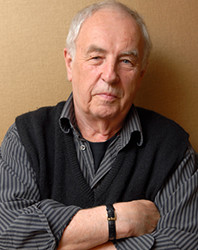 Founder and director of the nonprofit Creative Music Foundation, Inc., and creative leader of the legendary Creative Music Studio, Karl Berger is dedicated to the research of the power of music and sound and the elements common to all of the world’s music forms. In addition to his composing and playing, Karl is known around the world for educational presentations through workshops, concerts, recordings, and with a growing network of artists and CMS members worldwide.
Founder and director of the nonprofit Creative Music Foundation, Inc., and creative leader of the legendary Creative Music Studio, Karl Berger is dedicated to the research of the power of music and sound and the elements common to all of the world’s music forms. In addition to his composing and playing, Karl is known around the world for educational presentations through workshops, concerts, recordings, and with a growing network of artists and CMS members worldwide.
Karl Berger is a six time winner of the Downbeat Critics Poll as a jazz soloist, recipient of numerous Composition Awards (commissions by the National Endowment for the Arts, the New York State Council on the Arts, the Rockefeller Foundation, European Radio and Television: WDR, NDR, SWF, Radio France, Rai Italy. SWF-Prize 1994). Professor of Composition, Artist-in- Residence at universities, schools and festivals worldwide, PhD in Music Esthetics.
Karl Berger became noted for his innovative arrangements for recordings by Jeff Buckley (“Grace”), Natalie Merchant (“Ophelia”), Better Than Ezra, The Cardigans, Jonatha Brooke, Buckethead, Bootsie Collins, The Swans, Sly + Robbie, Angelique Kidjo and others; and for his collaborations with producers Bill Laswell, Alan Douglas (“Operazone”), Peter Collins, Andy Wallace, Craig Street, Alain Mallet, Malcolm Burn, Bob Marlett and many others in Woodstock, New York City, Los Angeles, Tokyo, London, Paris and Rome.
He recorded and performed with Don Cherry, Lee Konitz, John McLaughlin, Gunther Schuller, the Mingus Epitaph Orchestra, Dave Brubeck, Ingrid Sertso, Dave Holland, Ed Blackwell, Ray Anderson, Carlos Ward, Pharoah Sanders, Blood Ulmer, Hozan Yamamoto and many others at festivals and concerts in the US, Canada, Europe, Africa, India, Phillippines, Japan, Mexico and Brazil.
His recordings and arrangements appear on the Atlantic, Axiom, Black Saint, Blue Note, Capitol, CBS, Columbia Double Moon, Douglas Music, Elektra, EMI, Enja, Island, JVC, Knitting Factory, In&Out, MCA, Milestone, Polygram, Pye, RCA, SONY, Stockholm, Vogue and others.
Ingrid Sertso: Vocalist, Poet
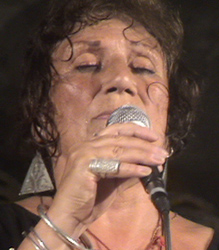 Through her work with such avant-jazz musicians as Don Cherry and Karl Berger, Ingrid Sertso established herself as a captivating, adventurous vocalist, capable of blending jazz, African, South American and other worldbeat influences into a distinctive, hypnotic sound.
Through her work with such avant-jazz musicians as Don Cherry and Karl Berger, Ingrid Sertso established herself as a captivating, adventurous vocalist, capable of blending jazz, African, South American and other worldbeat influences into a distinctive, hypnotic sound.
Although Sertso didn’t become well-known until the release of Dance with It in 1994, she spent over 20 years honing her art. During the late ’60s, she lived in Europe, leading her own trios and performing with the likes of Eric Dolphy, Don Cherry, Steve Lacy, Karl Berger and Leo Wright; she also worked as a music teacher at several institutions in Europe. In 1972, she became a permanent resident of the United States and she released her first album, We Are You, on Calig Records. Over the next few years she taught, while she performed in North America and Europe with the likes of Cherry, Ed Blackwell, Lee Konitz, Sam Rivers, Jimmy Giuffre, Bob Moses, Dave Holland, Perry Robinson and Jumma Santos. In 1974, she released Kalaparush on Trio Records in Japan. It was followed in 1975 by Peace Church Concerts on India Navigation/CMC Records.
In 1975, Sertso became a faculty member at the Naropa Institute in Boulder, Colorado. She stayed there through 1975 and 1976, before moving to the Banff Centre of Fine Arts in Calgary, Canada. She had two residencies at Banff before moving to the Creative Music Studio in Woodstock, New York, where she became the co-director. While working at the Creative Music Studio, she began singing in the Art of Improvisation with Berger and David Inzenon. In 1979, she toured major European cities as a solo artists, supported by the Woodstock Workshop Orchestra. She also released an album on MPS Records that year.
During the early ’80s, Sertso remained a co-director at the Creative Music Studio, while continuing to record and perform with a variety of musicians, including such mainstays as Don Cherry and Karl Berger, as well as Paulo Moura, Nana Vasconcelos, Steve Gorn, Dan Brubeck and Mike Richmond. In 1984, she performed with the Music Universe Orchestra at the Kool Festival in New York and released a duet album, Changing the Time, with Berger on Horo Records in Italy. She also toured Europe twice during this time and she also toured West Africa with Olatunji and Aiyb Dieng.
Sertso’s career picked up momentum during the latter half of the ’90s. She held a series of concerts and workshops in Rio de Janeiro, Brazil and she regularly tour the US on club and festival circuit. Sertso also toured Europe twice and sang solo vocals on Berger’s orchestral ballet, The Bird. She was one of the co-leaders of Rhythm Changes, who released the Jazzdance album on ITM Records. During these five years, she also performed and recorded with a variety of artists, including Pauline Oliveros, Lee Konitz, Frank Luther, Anthony Cox, Leroy Jenkins, Jimmy Cobber, Linda Montano and Karl Berger.
In 1990, Sertso catapulted back into the mainstream jazz spotlight through her version “Until the Rain Comes” on Don Cherry’s Multi Kulti album. Shortly afterward, she began working on a new album, but she became sidetracked by collaborating with Karl Berger and guitarist Paul Koji Shigihara. The trio blended original compositions with Sertso’s poetry, improvisations and interpretations of traditional tune. Sertso also regularly performed poetry readings at the Tinker Street Cafe in Woodstock and the Knitting Factory in New York, and she also regularly played clubs along the Northeast coast. In 1994, she released her comeback album Dance with It, which earned postitive reviews. —Stephen Thomas Erlewine (All Music Guide)
Ken Filiano: bassist
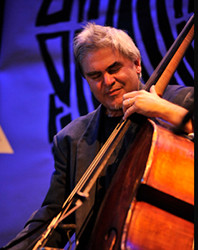 Bass player, composer, improviser, Ken FIliano has been performing throughout the world for thirty years, collaborating with leading artists in multiple genres, fusing the rich traditions of the double bass with his own seemingly limitless inventiveness. Ken leads two quartets, Quantum Entanglements, and Baudalino’s Dilemma (Vinny Golia, Warren Smith, Michael TA Thompson), and is a co-leader of The Steve Adams/Ken Filiano Duo and TranceFormation (Connie Crothers, Andrea Wolper.) His extensive discography includes a solo bass CD, subvenire (NineWinds), and Dreams From a Clown Car (Clean Feed), which presents his compositions for his quartet, Quantum Entanglements (Michael Attias, Tony Malaby, Michael TA Thompson). Ken has performed and/or recorded with Karl Berger, Bobby Bradford, Anthony Braxton, Connie Crothers Quartet, Bill Dixon, Ted Dunbar, Giora Feidman Quartet, Vinny Golia ensembles, Taylor Ho Bynum, Jason Kao Hwang, Joseph Jarman, Raul Juanena, Joelle Leandre, Frank London, Tina Marsh, Warne Marsh, Dom Minasi, Barre Phillips, Roswell Rudd, ROVA Saxophone Qt., Paul Smoker, Fay Victor Ensemble, Pablo Zielger, and many more. Ken is on the teaching roster at the New School in New York, and is a guest artist lecturer at School of Visual Arts and Hunter College (New York). He teaches master classes in bass and improvisation, and has a private bass studio in Brooklyn.
Bass player, composer, improviser, Ken FIliano has been performing throughout the world for thirty years, collaborating with leading artists in multiple genres, fusing the rich traditions of the double bass with his own seemingly limitless inventiveness. Ken leads two quartets, Quantum Entanglements, and Baudalino’s Dilemma (Vinny Golia, Warren Smith, Michael TA Thompson), and is a co-leader of The Steve Adams/Ken Filiano Duo and TranceFormation (Connie Crothers, Andrea Wolper.) His extensive discography includes a solo bass CD, subvenire (NineWinds), and Dreams From a Clown Car (Clean Feed), which presents his compositions for his quartet, Quantum Entanglements (Michael Attias, Tony Malaby, Michael TA Thompson). Ken has performed and/or recorded with Karl Berger, Bobby Bradford, Anthony Braxton, Connie Crothers Quartet, Bill Dixon, Ted Dunbar, Giora Feidman Quartet, Vinny Golia ensembles, Taylor Ho Bynum, Jason Kao Hwang, Joseph Jarman, Raul Juanena, Joelle Leandre, Frank London, Tina Marsh, Warne Marsh, Dom Minasi, Barre Phillips, Roswell Rudd, ROVA Saxophone Qt., Paul Smoker, Fay Victor Ensemble, Pablo Zielger, and many more. Ken is on the teaching roster at the New School in New York, and is a guest artist lecturer at School of Visual Arts and Hunter College (New York). He teaches master classes in bass and improvisation, and has a private bass studio in Brooklyn.
Maria Kim Grand: saxophonist, composer
 Saxophonist, composer, and educator María Grand was born in Switzerland in 1992, to a Swiss mother and an Argentinian father. Upon her moving to New York in 2011, she quickly became the protégée of legendary musicians such as Billy Harper, and Antoine Roney, as well as NEA Jazz Master Von Freeman; in just a few years, she became one of the few fresh and unique voices on her instrument. María recently completed her first orchestral work; she has composed for saxophone quartet as well as numerous pieces for her ensembles. She has lead her group DiaTribe at venues such as The Jazz Gallery; Seeds; Three Concentric Sections; Shapeshifter Lab; the Cell; in New York, and AMR Jazz Club and The Walden in Switzerland. She released her first opus “TetraWind” in February 2017. In recognition of her emerging talent, she was awarded one of three of the 2017 Jazz Gallery Commission Residencies, along with young masters Adam O’Farrill and Joel Ross; her new work will be premiered in June 2017.
Saxophonist, composer, and educator María Grand was born in Switzerland in 1992, to a Swiss mother and an Argentinian father. Upon her moving to New York in 2011, she quickly became the protégée of legendary musicians such as Billy Harper, and Antoine Roney, as well as NEA Jazz Master Von Freeman; in just a few years, she became one of the few fresh and unique voices on her instrument. María recently completed her first orchestral work; she has composed for saxophone quartet as well as numerous pieces for her ensembles. She has lead her group DiaTribe at venues such as The Jazz Gallery; Seeds; Three Concentric Sections; Shapeshifter Lab; the Cell; in New York, and AMR Jazz Club and The Walden in Switzerland. She released her first opus “TetraWind” in February 2017. In recognition of her emerging talent, she was awarded one of three of the 2017 Jazz Gallery Commission Residencies, along with young masters Adam O’Farrill and Joel Ross; her new work will be premiered in June 2017.
As a sideman, she has toured extensively with MacArthur Awardee Steve Coleman and his small ensemble, the Five Elements, as well as Steve Coleman and the Council of Balance and Steve Coleman and Natal Eclipse. She is a regular member of free funk/avant-garde jazz drummer, composer, poet, producer and professor Doug Hammond’s Quintet and of mridangam artist and scholar Rajna Swaminathan’s RAJAS. She also performs with Grammy Award winner Román Filiú in his groups Ouroboros and Quartería. María can be heard on Steve Coleman’s latest and critically acclaimed album, Synovial Joints.
As an educator, she regularly teaches private students. She has co-led “The Science of Jazz” at Lincoln Center with physicist Stephon Alexander; she has taught and helped teach workshops all over Europe, South America, and the United States, in institutions such as The Logan Center in Chicago, the Conservatory of Bologna in Italy, the Blue Whale in Los Angeles, as well as teaching informal improvisation workshops in Cuba and Colombia.
María has performed alongside musical luminaries Julian Priester, Vijay Iyer, Craig Taborn, Jen Shyu, Dafnis Prieto, Matt Mitchell, Marcus Gilmore, Adam Cruz, Anthony Tidd, Sean Rickman, Arthur Hoyle, Eric Alexander, Miles Okazaki, Damion Reid, among others; she has toured Europe, the United States, and South America, playing in venues and festivals such as the Village Vanguard in New York, La Villette Jazz Festival in Paris, Saafelden Jazz Festival in Austria, the Half Note Club in Athens, Millennium Park in Chicago, Roulette in Brooklyn, the Blue Whale in Los Angeles, the Northsea Jazz Festival (Netherlands), Porgy and Bess (Austria), Bird’s Eyes (CH), IloJazz Festival in Guadeloupe, Millennium Park in Chicago, etc.
Jane Scarpantoni: cellist, composer
 Jane is a classically trained cellist, composer and educator who has played on a number of alternative rock albums. She was a member of Hoboken, New Jersey’s Tiny Lights in the mid-’80s, then went on to play with other musicians especially those associated with the Hoboken underground rock scene of the 1980s and early 1990s, including Bruce Springsteen, Sheryl Crow, Patti Smith, Richard Barone, R.E.M., Indigo Girls, 10,000 Maniacs, Throwing Muses, Kristin Hersh, Lou Reed, Chris Cacavas, Bob Mould, John Lurie’s Lounge Lizards, Boo Trundle, Train and many others.
Jane is a classically trained cellist, composer and educator who has played on a number of alternative rock albums. She was a member of Hoboken, New Jersey’s Tiny Lights in the mid-’80s, then went on to play with other musicians especially those associated with the Hoboken underground rock scene of the 1980s and early 1990s, including Bruce Springsteen, Sheryl Crow, Patti Smith, Richard Barone, R.E.M., Indigo Girls, 10,000 Maniacs, Throwing Muses, Kristin Hersh, Lou Reed, Chris Cacavas, Bob Mould, John Lurie’s Lounge Lizards, Boo Trundle, Train and many others.
Register Now
About Full Moon Resort
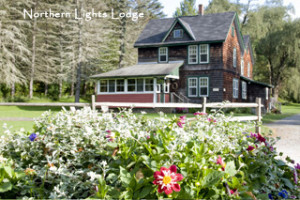
Full Moon Resort, located one half hour west of Woodstock, New York, “the most famous small town in the world,” is a year-round mountain resort located in the heart of the “Forever Wild” Catskill Forest Preserve. Dedicated to the celebration of nature, music and the arts, this one hundred-acre wonderland of mountains, fields, and streams is a world of its own.
Full Moon is an alternative to more traditional country inns and resorts – with educational, recreational and artistic workshops, weekend-long destination country weddings, cutting-edge music camps, and art exhibits all part of its magical landscape.
“Music and art in nature” is a central theme at Full Moon Resort. Music is always in the air with the Music Masters Camp series, a special mid-week interactive musical experience with world renowned artists – complete with superb dining, comfortable country inn accommodations, and camping options.
Lovingly prepared, fresh, healthy cuisine served by a friendly, professional staff is the trademark of Full Moon Catering. The menus offer a full range of possibilities – hot buffet breakfasts and lunches, down-home country barbeques …tantalizing hors d’oeuvres and formal gourmet dinners in the Tent Pavilion. Fresh, natural ingredients (often organic) are the common thread throughout.
Accommodations are charming in their simplicity, with guest rooms available in a variety of lodges – some in a simple B&B style with shared hallway baths and others with private bath options.
In all, Full Moon Resort, with its picturesque grounds, cozy guest accommodations, excellent cuisine and friendly, professional staff, sets the stage for highly memorable experiences for those attending the Music Masters Camps.
Full Moon contact info:
E-mail: [email protected]
Telephone: 845-254-8009
Monday-Friday, 9am-5pm (EST)
Register Now
FAQ
When will my deposit be run? Your deposit will be run at the time of your registration.
What gear do I need? Bring your instrument(s) if they fit! Amps are not required. For more information, email [email protected] to see what will be provided.
What about beer/alcohol? CMS realizes that many of you want to consume alcoholic beverages at dinner and at night during performances and jams. To accommodate those who choose to drink, CMS has arranged to have wine/beer available at dinner and later at performances. Please help chip in by placing $5-$10/day into the bar-jar if you choose to drink alcohol. There are always complimentary alcohol-free beverages available, too.
Can I still come if I’m not a musician?
Non-musicians are more than welcome and encouraged to attend. Vocalists and dancers are encouraged, too. We love listeners.
What skill level is required to attend?
Classes and curriculum are developed to accommodate all ranges of playing. All classes are optional and open to everyone.
Is there an age requirement? No. Minors are required to submit a parent/legal guardian consent form.
Are meals included? Three gourmet meals a day and snacks are included in your tuition.
If I want to bring my spouse, but they don’t want to attend classes, can I? Yes. In order to bring a non-participant, you would need to purchase a “single occupancy” package. Non-participants have access to all meals and Full Moon facilities. Additional fees may apply. Call Full Moon to discuss.
When is check in and check out? Check in is at 3pm on arrival day and check out is at 11am on departure day. Due to Full Moon’s busy event calendar, it is generally not possible to check in early or check out late.
How do I get there? Please see the ‘Directions/Transportation’ section below.
Is there cell phone reception at camp?
No! There is no cell phone reception at Full Moon Resort. Complimentary phone service for all calls within the U.S. is available at all times at the Inn. Also, there is complimentary Wi-Fi available throughout the facility.
How do I make my final payment?
Your final payment will be automatically run on the credit card on file on the due date noted in your registration form. You may provide an alternative method of payment as long as it is received before the due date.
Can I take photos, video or audio recordings?
Yes. You may be required to sign a waiver stating all recordings, footage and/or photos will be used strictly for personal use and not commercially. CMS will ask you to sign a ‘release form’ for the organization’s use of audio and video recorded at the workshop.
What is the weather like at camp? Weather in the Catskills varies. In the spring, you can expect warm days (low 60s to upper 70s) and cooler nights (lower 40s to lower 60s). Fall can be cold – it can get into the 40s at night. Be prepared in case it’s cold.
What do you suggest I bring with me? Audio recording devices , camera, clothes & toiletries (toothbrush, soap, shampoo etc…) – basically what you would bring to a hotel. Tent Campers- don’t forget towels, sleeping bags, tarps, etc.! Please bring paper, pen, music stand, staff paper, water bottles, and cash for evening bars (There is no ATM on-site.)
Do you provide equipment storage for tent campers? This can be arranged on an as needed basis.
Can I select my own roommate? Yes – if that person is signed up as well. We cannot hold a spot for someone unless they have already registered.
How does the facility select my roommate? Full Moon Resort selects roommates based on age and gender. You will always be placed with a same-sex roommate.
Pricing and Registration
Camp Packages are All-Inclusive!
Monday to Friday you will have access to all workshops, seminars, gourmet meals, performances, and camp activities. The only thing you have to do after signing up is get here!
All camp activities will be held at Full Moon Resort. Full Moon features an eclectic array of comfortable, rustic country-inn accommodations including simple B&B style guest rooms with shared hallway baths and guest rooms with private baths. “Primitive” campsites are also available. All accommodations are just steps away from daily music camp activities. The grounds offer one hundred acres of meadows, forests and streams providing a natural backdrop for an unforgettable, enriching experience.
Guest rooms at Full Moon do not have telephones, TV’s, air conditioning or daily housekeeping service. Wi-Fi, cable television and complimentary phone service are all available at the Inn (please bring a phone card for international calls). Enjoy the spring-fed swimming pool, on-site access to the Esopus Creek, and explore the splendors of the Catskills on the nearby network of hiking trails.
Please Note: There is no cell phone reception at Full Moon Resort or in Big Indian but there is a house phone free of charge.
Package Pricing Note: Prices do not include applicable fees or a $5 – 10/day beer/wine charge if you choose to drink at dinner and at evening performances. As a nonprofit, CMS does not charge taxes and can pass the roughly 10% savings on to participants.
Full Moon Resort Accommodations:
Note: Prices include Full Moon Resort lodging, food and CMS workshops and performances. Prices do not include applicable fees or $5 – 10/day beer/wine fee. As a nonprofit, CMS does not charge taxes and can pass the roughly 10% savings on to participants.
Rates:
- $695 Tent Camping
- $995 Double Occupancy, Shared Bath
- $1,095 Double Occupancy, Private Bath
- $1,395 Single Occupancy, Shared Bath
- $1,595 Single Occupancy, Private Bath
- $495 Non-participant rates for spouse/children
Registration, Payment and Cancellation Terms and Conditions:
Your decision to register for Full Moon Resort Music Masters Camps constitutes your acknowledgement of and consent to all of the registration, payment and cancellation terms and conditions listed below.
Registration and Payments:
- All rates are per-person
- Since CMS is a nonprofit, we do not have to charge sales tax but we will charge a 1.5% online registration fee
- Upon registration, a non-refundable deposit of $350 is charged to your credit card
- 100% of the remaining balance due is automatically charged to the credit card on file on September 9, 2017
- Any registrations received after September 9, 2017, must be paid in full at the time of registration
Cancellation:
All payments and deposits are non-refundable, except when approved by the Creative Music Foundation.
- Cancellations received before September 9, 2017 will not be charged the remaining balance.
- Cancellations received after September 9, 2017 will be charged the full remaining balance.
Due to the nature of our events and strict cancellation policies, Creative Environments, LLC DBA Full Moon Resort strongly suggests purchasing travel insurance.
Register Now
Full Moon contact info:
E-mail: [email protected]
Telephone: 845-254-8009
Monday-Friday, 9am-5pm (EST)
Traveling to Full Moon Resort
CMS Workshops are held in Big Indian, New York, which is centrally located in the heart of the “Forever Wild” Catskill forest preserve.
Full Moon Resort:
1 Valley View Road
, Big Indian, NY 12410
Directions to Full Moon Resort
By Car: Parking is complimentary for all participants.
From Albany and points North: Take the New York State Thruway (I-87) South towards New York City. Take Exit 19, Kingston (see below)
From New York City and Points South: Take the New York State Thruway (I-87) North/West to Exit 19, Kingston. After toll, merge slightly right onto Route 28 West (towards Pine Hill) . Travel approximately 30 miles on Route 28 West to Big Indian/Oliverea. Turn left onto County Route 47 (just after a brown sign on Route 28 which says Oliverea 3 miles). Proceed 5 miles on County Route 47 (Oliverea Road). You will see signs for Full Moon on the right-hand side.
By Plane: The closest airports to Big Indian are one hour and thirty minutes away: Albany International Airport and Stewart/Newburgh International Airport.
- Albany International Airport (ALB): 737 Albany Shaker Rd., Albany, NY 12211. Phone: (518) 242.2222 http://www.albanyairport.com/
- Stewart-Newburgh International Airport (SWF): 1180 1st Street , New Windsor, NY 12553 Phone: (845) 564-2100 http://www.panynj.gov/airports/stewart.html
- JFK and LaGuardia Airports in New York City are approximately two and a half hours from Big Indian. Airport Car Services: Woodstock Town Car Service: (845) 679-6656 ; Black Diamond Transportation: (845) 338-8426.
By Bus: Adirondack Trailways buses run from NYC and Kingston, NY. There is a stop on Route 28 at the Big Indian post office, just five miles from Full Moon Resort. Email us at [email protected] to arrange a pick up from the Big Indian bus stop to Full Moon Resort.
NYC buses depart from the Port Authority bus terminal in Manhattan at 9.30am, 12.30pm and 3.30pm (EST) daily and take approximately three hours to reach Big Indian. One way fare is approximately $35, return is approximately $70. For additional schedule information and bus stop locations, visit www.trailwaysny.com or call 1-800-776-7548
Big Indian Bus Stop Located At the Big Indian Post Office: 8279 State Route 28, Big Indian, NY 12410. *Email [email protected] to let us know when you will be arriving and we will be sure to have a shuttle waiting to bring you to camp!
By Train: The closest train station is in Rhinecliff, NY which is approximately one hour away from Big Indian.
Rhinecliff Amtrak Station (RHI): Hutton St. and Charles St., Rhinecliff, NY 12574 Phone: 1 (800) 872-7245 . Station and Service Hours: Open 7 Days a Week: 5:30am-10:30pm
**Carpooling is suggested!
